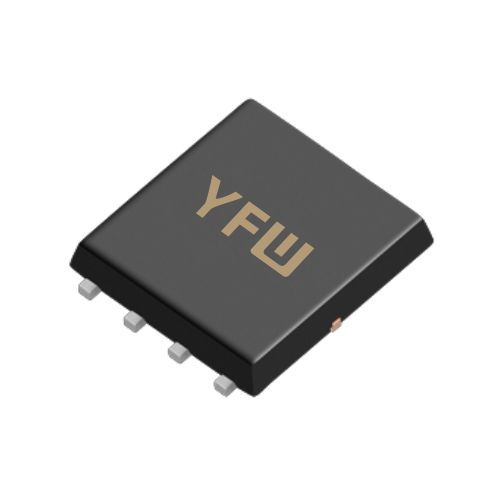A UJT is constructed on a lightly doped N-type silicon bar, with two ohmic contacts—termed the first base (B₁) and second base (B₂)—attached to opposite ends. These bases serve as the primary terminals for voltage supply and current flow. Near the B₂ end, a heavily doped P-type region is alloyed into the silicon bar, forming a single PN junction with the N-type substrate. This P-type region connects to the third terminal, the emitter (E), which is typically labeled with an arrow indicating the direction of conventional current flow (from P to N, i.e., into the N-type silicon).
The key structural feature is the high resistivity of the N-type silicon bar, which creates a resistive path between B₁ and B₂. The emitter junction is positioned closer to B₂, skewing the physical layout to influence the device’s electrical characteristics. This asymmetry results in a critical parameter called the intrinsic standoff ratio (η), defined as the ratio of the resistance between the emitter and B₁ (R_B₁) to the total resistance between B₁ and B₂ (R_B₁ + R_B₂). Mathematically, η = R_B₁ / (R_B₁ + R_B₂), typically ranging from 0.5 to 0.8 for most UJTs.
In circuit diagrams, the UJT is represented by a symbol that visually captures its structure and polarity. The symbol features two base terminals (B₁ and B₂) connected to the ends of a straight line, representing the N-type silicon bar. The emitter is denoted by an arrow intersecting the line, pointing toward B₁ to signify the direction of current flow when the PN junction is forward-biased. Unlike the bipolar transistor’s symbol, which uses three lines for collector, base, and emitter, the UJT’s symbol emphasizes its two-base configuration and single junction, avoiding confusion with multi-junction devices.
A standard UJT symbol ensures clarity in schematics, allowing engineers to identify its role in relaxation oscillators or timing circuits where its negative-resistance property is exploited. The arrow’s direction is crucial: it must point toward B₁ to denote that the emitter injects holes into the N-type bar, a key aspect of its operation.
To analyze UJT circuits, engineers use an equivalent circuit that models its resistive and diode characteristics. The core components of this model are:
Base Resistance (R_BB): The total resistance between B₁ and B₂, equal to R_B₁ + R_B₂, typically ranging from 4 to 10 kΩ.
Intrinsic Voltage Divider: Formed by R_B₁ and R_B₂, which sets the voltage at the emitter junction relative to B₁. When no voltage is applied to the emitter, the voltage at the junction (V_P) is ηV_BB, where V_BB is the bias voltage across B₁ and B₂.
Forward-Biased Diode: Representing the PN junction between the emitter and the silicon bar. When the emitter voltage (V_E) exceeds V_P + V_D (V_D being the diode’s forward voltage drop, ~0.7V), the diode turns on, injecting holes into the N-type material and reducing R_B₁ significantly.
The equivalent circuit illustrates the UJT’s negative-resistance region: once the emitter conducts, R_B₁ decreases rapidly, causing a drop in V_E despite an increase in emitter current. This behavior is critical for triggering oscillations in circuits like the 弛张振荡器 (relaxation oscillator, described here as "relaxation oscillator"), where the UJT discharges a capacitor through B₁, creating periodic voltage spikes.
Off State: With V_E < V_P + V_D, the emitter diode is reverse-biased, and the UJT acts as a high-resistance device between B₁ and B₂.
Triggering: When V_E surpasses V_P + V_D, the diode forward-biases, injecting carriers into the silicon bar. This lowers R_B₁, creating a low-resistance path from E to B₁.
Negative Resistance Region: As emitter current (I_E) increases, V_E decreases due to the drop in R_B₁, showcasing negative differential resistance.
Saturation: I_E reaches a peak (I_P), after which further increases in I_E result in positive resistance as R_B₁ stabilizes.
This model simplifies the design of timing circuits, where a capacitor charged through a resistor discharges through the UJT once the trigger voltage is reached, generating precise pulses.
While UJTs have been partially overshadowed by more versatile devices like BJTs and FETs, their unique negative-resistance behavior and simplicity make them ideal for low-power, low-frequency applications:
Relaxation Oscillators: Generating periodic signals for timing circuits in alarms or power supplies.
Synchronization Circuits: Triggering other devices in phase with a reference signal.
Voltage-Controlled Oscillators (VCOs): Where the intrinsic standoff ratio allows frequency adjustment via bias voltage.
Their equivalent circuit model remains a fundamental tool for engineers, enabling quick analysis of charging/discharging dynamics and oscillation frequencies without complex simulations.
The unijunction transistor, though simpler in structure than its multi-junction counterparts, carves out a unique niche in electronics through its single PN junction and negative-resistance properties. Its circuit symbol clearly distinguishes it from other transistors, while the equivalent circuit model demystifies its behavior, bridging physical structure with electrical characteristics. By understanding these fundamentals, designers can harness the UJT’s strengths in applications where simplicity and reliable oscillation take precedence, proving that even "basic" components hold enduring value in modern circuit design
